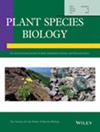Variability of the sexual reproductive part in stinging nettle Urtica dioica L. (Urticaceae): From flower to genet
IF 1.3
4区 生物学
Q4 ECOLOGY
引用次数: 0
Abstract
Stinging nettle,刺荨麻(荨麻科)有性生殖部分的变异性:从花到基因
荨麻(Urtica dioica L.)是一种分布广泛的亚雌雄异株长根状茎植物。在莫斯科国立罗蒙诺索夫大学兹韦尼戈罗德生物站境内的一个种群中,我们在荨麻丛中选取了八个地块,研究荨麻有性生殖部分的变异取决于内部和外部因素。由于雌雄同株的柱头在所研究的种群中比较常见,因此根据雌雄花的比例区分了四种性别形式。在 156 个不同性别形式的柱头和 36 个基因组中发现,与其他性别形式的植株相比,以雄性为主的植株较矮,而以雌性为主的植株花序较大且分布较广。短柔毛类型(平展或贴伏的单细胞毛)在子实体中的重复性最高。刺荨麻中真正的雌雄同株现象非常普遍:在 36 个基因组中有 10 个发现了不同性别形式的雄花和雌花。研究种群中最常见的花序结构类型是近雌蕊和基雌蕊。在同一子房上既能发现正常的雌花和正常的雄花,也能发现根据不同性别的花形成的形态异常的花,这表明存在雌雄异株的易变性。
本文章由计算机程序翻译,如有差异,请以英文原文为准。
求助全文
约1分钟内获得全文
求助全文
来源期刊

Plant Species Biology
生物-生态学
CiteScore
2.70
自引率
14.30%
发文量
36
审稿时长
>12 weeks
期刊介绍:
Plant Species Biology is published four times a year by The Society for the Study of Species Biology. Plant Species Biology publishes research manuscripts in the fields of population biology, pollination biology, evolutionary ecology, biosystematics, co-evolution, and any other related fields in biology. In addition to full length papers, the journal also includes short research papers as notes and comments. Invited articles may be accepted or occasion at the request of the Editorial Board. Manuscripts should contain new results of empirical and/or theoretical investigations concerning facts, processes, mechanisms or concepts of evolutionary as well as biological phenomena. Papers that are purely descriptive are not suitable for this journal. Notes & comments of the following contents will not be accepted for publication: Development of DNA markers. The journal is introducing ''Life history monographs of Japanese plant species''. The journal is dedicated to minimizing the time between submission, review and publication and to providing a high quality forum for original research in Plant Species Biology.
 求助内容:
求助内容: 应助结果提醒方式:
应助结果提醒方式:


